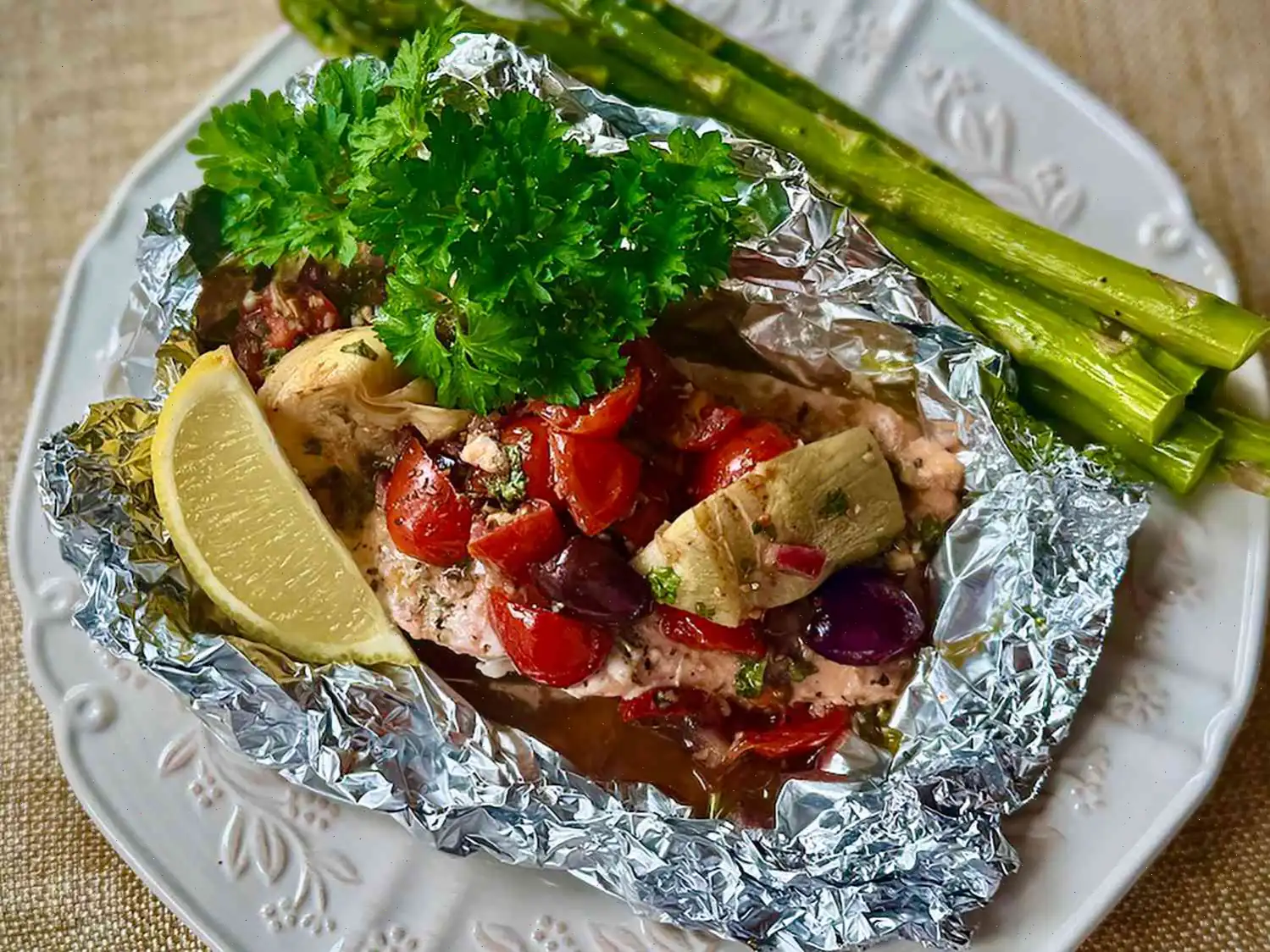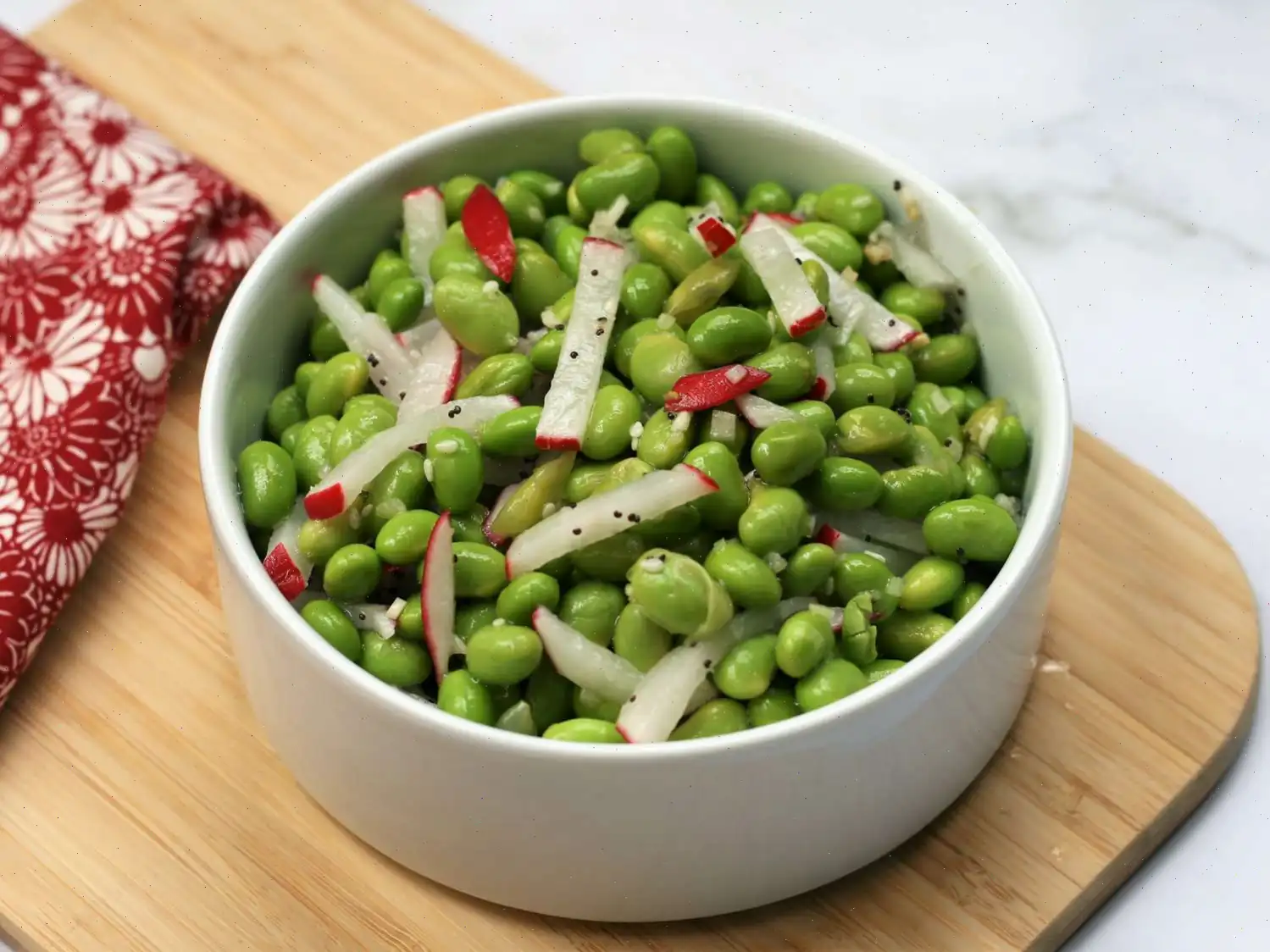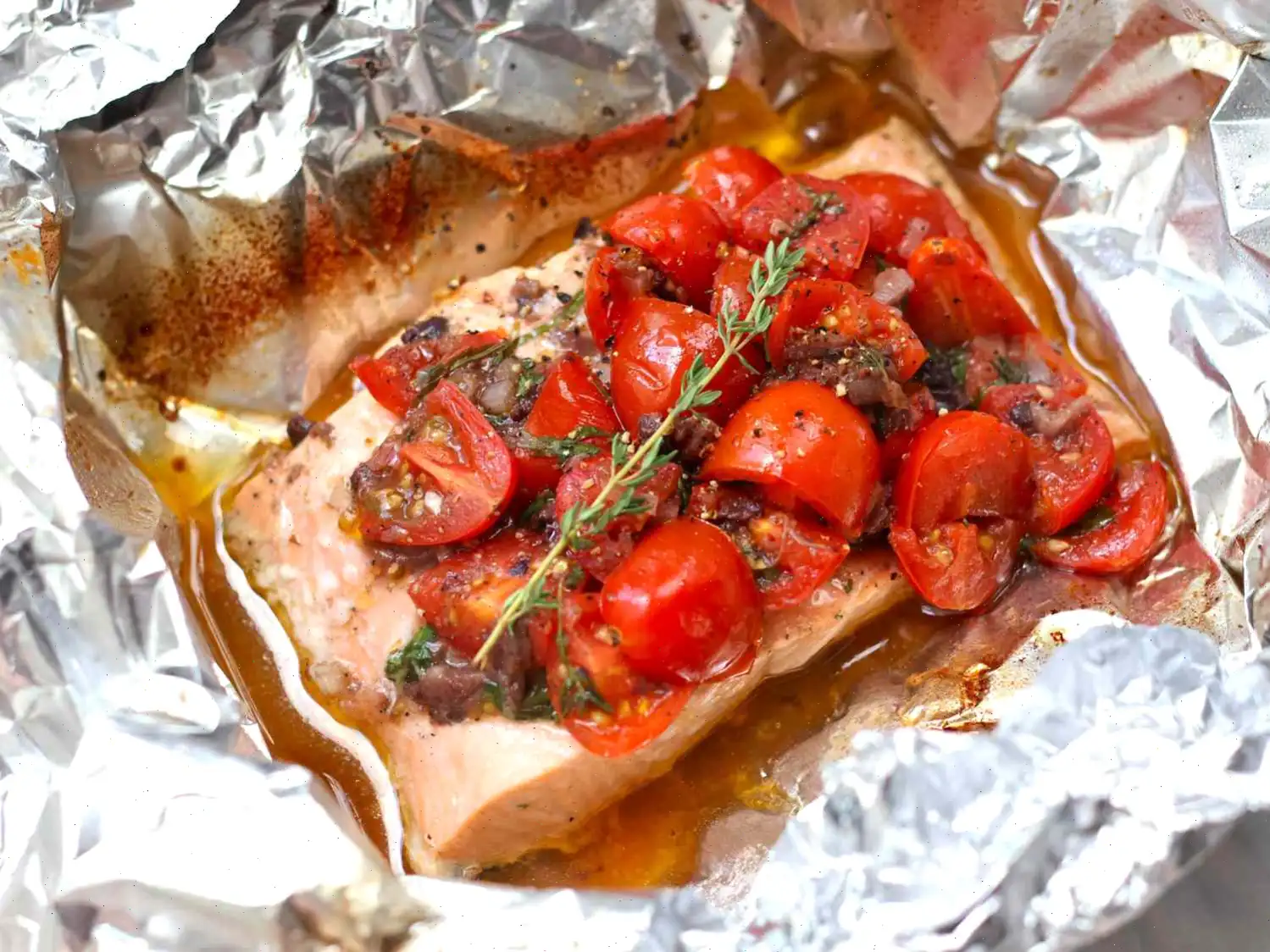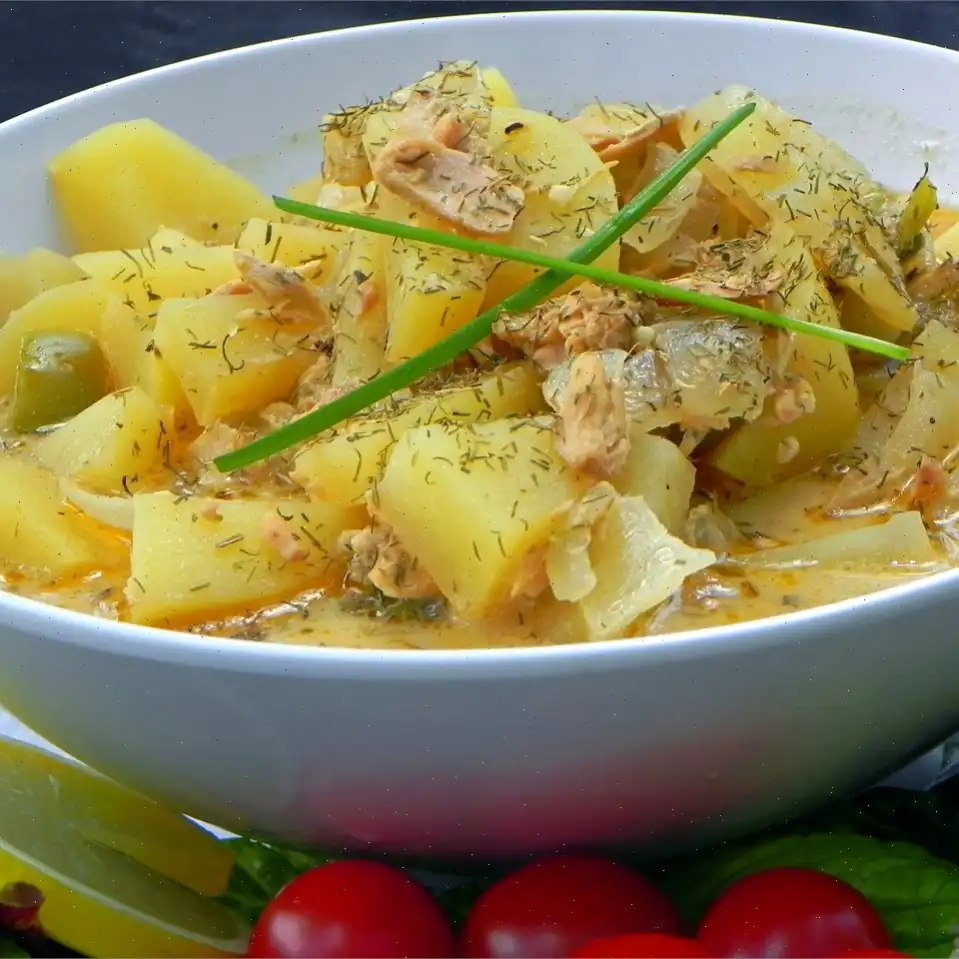
Mediterranean Salmon Baked in Foil Recipe
Ingredients
- 4 (12x16-inch) rectangles aluminum foil
- 4 (6 to 8 ounce) salmon filets
- 3 tablespoons olive oil, divided
- 1 teaspoon Greek seasoning
- 1 cup diced cherry or grape tomatoes
- 4 marinated artichoke hearts, quartered
- 3 tablespoons minced red onion
- 3 tablespoons halved, pitted Kalamata olives
- 1/2 lemon, zested and juiced
- 2 tablespoons minced fresh parsley, plus sprigs for garnish (optional)
- 1 tablespoon balsamic vinegar
- 2 cloves garlic, minced
- 1/4 teaspoon red pepper flakes (optional)
- Salt and freshly ground black pepper
- 1 lemon, cut into wedges (optional)
Directions
- Preheat your oven to 400F (200C). Lay out four sheets of aluminum foil, each about 12x16 inches, on a flat surface. Lightly brush the center of each with olive oil.
- Place one salmon filet in the center of each foil sheet. Drizzle the filets with a little more olive oil and sprinkle with Greek seasoning to taste.
- In a small mixing bowl, combine the diced tomatoes, quartered artichoke hearts, minced red onion, Kalamata olives, lemon zest and juice, minced parsley, balsamic vinegar, minced garlic, and red pepper flakes (if using). Stir everything together and season with salt and pepper to taste.
- Spoon the prepared tomato mixture evenly over the salmon filets, spreading it out generously.
- Carefully fold the long sides of the foil over the salmon, then crimp the edges twice to seal the packet, ensuring the foil does not touch the contents. Pinch the ends together to completely close the packet.
- Place the foil packets on a rimmed baking sheet and bake in the center of your preheated oven for 12 to 15 minutes. The salmon is done when an instant-read thermometer inserted into the center reads 145F (63C).
- To serve, carefully open the foil packets and transfer the salmon and its contents onto serving plates. Drizzle with any remaining olive oil, garnish with fresh parsley sprigs, and serve with lemon wedges on the side for an extra burst of flavor.
Nutrition Facts
| Nutrition Information (per serving) | Amount |
|---|---|
| Calories | 616 |
| Total Fat | 40g |
| Saturated Fat | 7g |
| Cholesterol | 143mg |
| Sodium | 721mg |
| Total Carbohydrates | 10g |
| Dietary Fiber | 2g |
| Total Sugars | 6g |
| Protein | 51g |
| Vitamin C | 16mg |
| Calcium | 59mg |
| Iron | 2mg |
| Potassium | 1020mg |
*Percent Daily Values are based on a 2,000-calorie diet. Your daily values may be higher or lower depending on your calorie needs.
The Origins of Mediterranean Salmon Baked in Foil
The concept of baking salmon in foil has roots in traditional Mediterranean cooking, where simple ingredients are combined to enhance the natural flavors of fish. This method, often referred to as "en papillote" when using parchment in French cuisine, allows the fish to steam in its own juices while absorbing the aromas of herbs, olives, and vegetables. Over centuries, Mediterranean coastal communities adapted this technique using local ingredients such as olive oil, lemon, tomatoes, and artichokes, creating a dish that is both healthy and aromatic.
Regional Characteristics
This recipe reflects the Greek influence within Mediterranean cuisine. The use of Kalamata olives, Greek seasoning, and balsamic vinegar gives the salmon a distinct regional flair. In Southern Europe, variations often include capers, oregano, or fresh thyme, depending on the local availability of produce. The Mediterranean diet emphasizes balance and fresh ingredients, making this dish not only flavorful but aligned with the nutritional principles celebrated across the region.
How It Differs from Similar Dishes
Unlike traditional baked salmon, which is often roasted openly on a pan, the foil-baked method traps moisture and flavors inside the packet. This results in a tender, juicy texture that is less common in dry baking methods. Compared to other Mediterranean seafood dishes, this recipe is lighter, relying on fresh vegetables and minimal oil rather than heavy sauces or cream-based preparations. The balance of acidity from lemon and sweetness from tomatoes creates a complex flavor profile unique to this style.
Typical Serving Occasions
Mediterranean salmon baked in foil is versatile and often served as a main course for family dinners, casual gatherings, or elegant dinner parties. Its individual foil packets make it convenient for portioning and presentation, perfect for serving directly at the table. It pairs beautifully with sides like couscous, roasted vegetables, or a light green salad, embodying the Mediterranean emphasis on fresh, wholesome meals.
Interesting Facts
- Foil baking preserves nutrients better than many other cooking methods, retaining vitamins and omega-3 fatty acids found in salmon.
- This cooking method was historically used by fishermen and coastal villagers to cook over open fires, wrapping fish in leaves or foil-like materials.
- The combination of lemon, garlic, and olive oil not only enhances flavor but also promotes heart health, consistent with Mediterranean diet principles.
- Many chefs consider this recipe a canvas for seasonal ingredients, easily adjusted with zucchini, bell peppers, or fresh herbs depending on the harvest.
FAQ about Mediterranean Salmon Baked in Foil Recipe
Comments
Brenda Wright
10/21/2023 05:58:48 PM
This recipe is incredibly delicious and perfect for a visually appealing, gourmet dinner that is surprisingly simple to prepare. Although the Greek seasoning recipe is not included in this recipe, it can be found on this site under "Greek Seasoning Blend".
Daniel Edwards
02/20/2025 08:32:13 AM
Great for our family of four! Everyone loved it. I prepared a batch of Greek Seasoning yesterday. I initially used a teaspoon to season the salmon, but later switched to a 1/4 teaspoon and used it four times!
Daniel Flores
08/18/2023 05:26:35 AM
My husband, who has diabetes, has seen a significant improvement in his blood sugar levels since starting the Mediterranean diet.
Patrick Flores
07/21/2024 10:33:58 PM
This recipe was absolutely delicious as is. My wife usually can't stand tomatoes because of their texture, but she actually enjoyed every bite of them in this dish. This recipe has earned a permanent spot in my cooking rotation.








